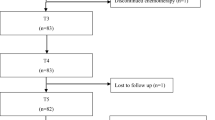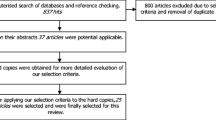Abstract
Purpose
This prospective study was performed to evaluate the effect of chemotherapy-related neurotoxicity on quality of life (QOL) of patients with lymphoma.
Methods
Thirty-two patients with diffuse large B-cell or follicular lymphoma without prior evidence of neuropathy were enrolled. Patients underwent the evaluations based on neuropathy symptom and disability score, nerve conduction studies, and SF-36 questionnaire for QOL assessment. They received six cycles of chemotherapy every three weeks, and all evaluations were repeated during and after the completion of 6th cycle.
Results
Sensory neuropathy-associated symptoms were observed in 27 patients (84.4%), and polyneuropathy was confirmed by nerve conduction study in 14 patients (43.8%). These patients with polyneuropathy showed worse QOL in domains mainly associated with physical health status including “physical function” compared to patients without polyneuropathy. There was a significant association of neuropathy symptom and disability scores with “bodily pain” and “vitality” of QOL domains. The serial evaluations of patients with neuropathy showed a worsening of QOL and neuropathy symptom scores during chemotherapy, then improvement of these values after chemotherapy. Thus, the final nerve conduction study confirmed the decrease in polyneuropathy compared to the 2nd evaluation (P = 0.032).
Conclusion
Chemotherapy-related polyneuropathy may deteriorate QOL of patients with lymphoma, mainly physical health-associated QOL.
Similar content being viewed by others
References
van Oers, M. H., Klasa, R., Marcus, R. E., Wolf, M., Kimby, E., Gascoyne, R. D., et al. (2006). Rituximab maintenance improves clinical outcome of relapsed/resistant follicular non-Hodgkin lymphoma in patients both with and without rituximab during induction: results of a prospective randomized phase 3 intergroup trial. Blood, 108, 3295–3301.
Coiffier, B., Lepage, E., Briere, J., Herbrecht, R., Tilly, H., Bouabdallah, R., et al. (2002). CHOP chemotherapy plus rituximab compared with CHOP alone in elderly patients with diffuse large-B-cell lymphoma. New England Journal of Medicine, 346, 235–242.
Morita, S., Kobayashi, K., Eguchi, K., Matsumoto, T., Shibuya, M., Yamaji, Y., et al. (2003). Influence of clinical parameters on quality of life during chemotherapy in patients with advanced non-small cell lung cancer: Application of a general linear model. Japanese Journal of Clinical Oncology, 33, 470–476.
Bruner, D. W., Barsevick, A., Tian, C., Randall, M., Mannel, R., Cohn, D. E., et al. (2007). Randomized trial results of quality of life comparing whole abdominal irradiation and combination chemotherapy in advanced endometrial carcinoma: A gynecologic oncology group study. Quality of Life Research, 16, 89–100.
Ahles, T. A., Saykin, A. J., Furstenberg, C. T., Cole, B., Mott, L. A., Titus-Ernstoff, L., et al. (2005). Quality of life of long-term survivors of breast cancer and lymphoma treated with standard-dose chemotherapy or local therapy. Journal of Clinical Oncology, 23, 4399–4405.
Doorduijn, J., Buijt, I., Holt, B., Steijaert, M., Uyl-de Groot, C., & Sonneveld, P. (2005). Self-reported quality of life in elderly patients with aggressive non-Hodgkin’s lymphoma treated with CHOP chemotherapy. European Journal of Haematology, 75, 116–123.
Klasa, R. J., Meyer, R. M., Shustik, C., Sawka, C. A., Smith, A., Guevin, R., et al. (2002). Randomized phase III study of fludarabine phosphate versus cyclophosphamide, vincristine, and prednisone in patients with recurrent low-grade non-Hodgkin’s lymphoma previously treated with an alkylating agent or alkylator-containing regimen. Journal of Clinical Oncology, 20, 4649–4654.
Wilkes, G. (2007). Peripheral neuropathy related to chemotherapy. Seminars in Oncology Nursing, 23, 162–173.
Dyck, P. J. (1988). Detection, characterization, and staging of polyneuropathy: Assessed in diabetics. Muscle and Nerve, 11, 21–32.
Ware, J. E., Kosinski, M., & Keller, S. D. (1994). SF-36 physical and mental health summary scales: A user’s manual. Boston, MA: The Health Institute.
Armstrong, T., Almadrones, L., & Gilbert, M. R. (2005). Chemotherapy-induced peripheral neuropathy. Oncology Nursing Forum, 32, 305–311.
Hausheer, F. H., Schilsky, R. L., Bain, S., Berghorn, E. J., & Lieberman, F. (2006). Diagnosis, management, and evaluation of chemotherapy-induced peripheral neuropathy. Seminars in Oncology, 33, 15–49.
Ware, J. E., Jr. (2000). SF-36 health survey update. Spine, 25, 3130–3139.
Author information
Authors and Affiliations
Corresponding author
Rights and permissions
About this article
Cite this article
Kim, BJ., Park, HR., Roh, H.J. et al. Chemotherapy-related polyneuropathy may deteriorate quality of life in patients with B-cell lymphoma. Qual Life Res 19, 1097–1103 (2010). https://doi.org/10.1007/s11136-010-9670-0
Accepted:
Published:
Issue Date:
DOI: https://doi.org/10.1007/s11136-010-9670-0




